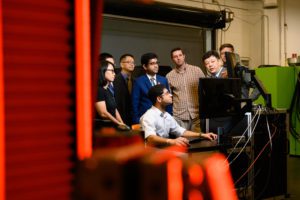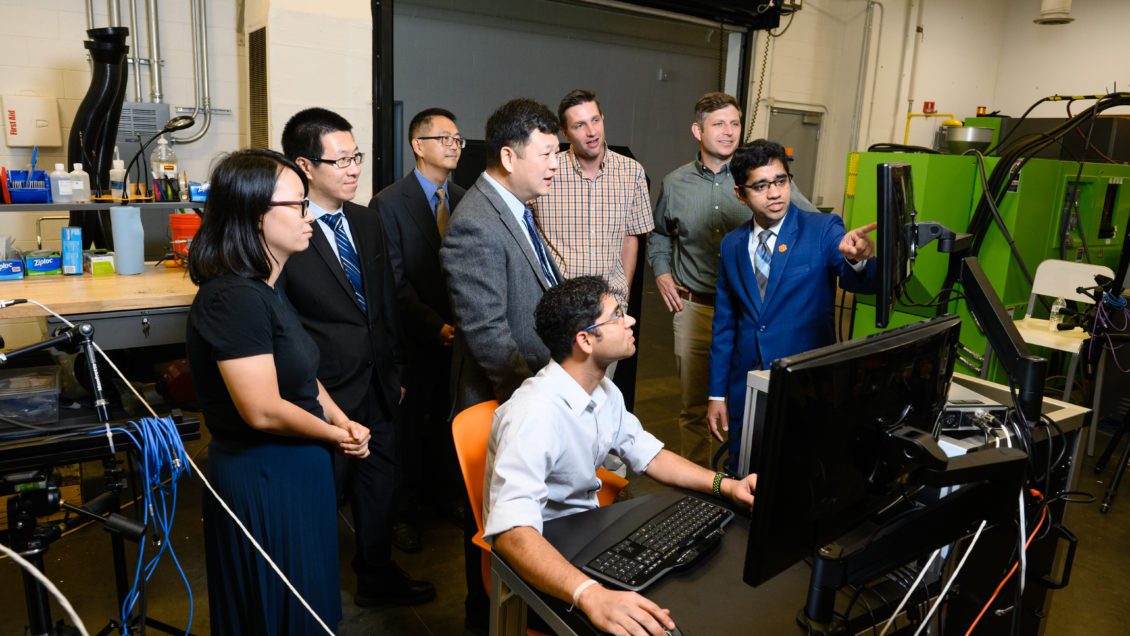Part of what makes the new AIM for Composites Center at Clemson University stand out is the coast-to-coast multidisciplinary team that is coming together to develop what promises to be a transformational way of creating composite materials.
While the center is based at the Clemson University International Center for Automotive Research in Greenville, its reach is nationwide with several universities and national labs involved.

Srikanth Pilla, the founding director of AIM for Composites, said that when he was building the team, he sought out the nation’s top talent.
“We found some of our team members here at Clemson and some at other universities and national labs,” Pilla said. “We have assembled the best of the best and are well positioned for maximum impact.”
The center will receive $10.35-million in support from the U.S. Department of Energy’s Office of Science. AIM for Composites is one of the department’s Energy Frontier Research Centers.
Researchers with AIM for Composites are developing a system that would allow manufacturers to tell a computer what properties they want in a composite material, and then the computer would use artificial intelligence and a technique called inverse engineering to describe how to make it.
Gang Li, a Clemson mechanical engineering professor at Clemson, said the center underscores that artificial intelligence is transforming engineering and manufacturing and how products are designed.
“To me, it is the equivalent of 50 years ago when computer-aided design and computer-aided manufacturing first emerged,” Li said. “We are looking at a major evolutionary change in the field of design, engineering, material science and manufacturing. That is the most important and most exciting part of this project from my point of view.”
Farhang Pourboghrat, professor and chair of the Integrated Systems Engineering Department at Ohio State University, said the center will help advance composites material technology.
“We will utilize experimentally validated computational models and artificial intelligence to transform how composite materials are created,” Pourboghrat said. “I look forward to extending my collaboration with Clemson University with this important project.”
Feng Luo, the Marvin J. Pinson, Jr. ’46 Distinguished Professor in Clemson’s School of Computing, has applied AI to a wide range of topics, including biomedical images, genomics and transportation. AIM for Composites will give him a chance to turn his attention to another domain.
“We are providing AI expertise to the center, and we have some great AI tools that we can apply to creating composite materials,” said Luo, who is also the founding director of the Clemson Artificial Intelligence Research Institute for Science and Engineering (AIRISE).
Nikunja Swain, chair of the Computer Science and Mathematics Department at South Carolina State University, said the project will help strengthen the university’s educational and research activities in data science, artificial intelligence, manufacturing and related topics.
“In addition, this project will prepare the next generation of STEM students to address issues relative to the use of AI in the manufacturing paradigm for composites,” Swain said. “Student projects will be designed to develop and implement systems and practices to capture and aggregate evidence of knowledge and skills in technologies and practices associated with manufacturing platforms.”
Zhen Li, an assistant professor of mechanical engineering at Clemson, said he will develop AI-based models that will help accelerate the design of the materials that researchers will create.
“If we create physically-informed models of new designs, it usually takes hours or even days to see if the design is good or not,” he said. “We can reduce hours or days to one second.”
George Em Karniadakis, The Charles Pitts Robinson and John Palmer Barstow Professor of Applied Mathematics and Engineering at Brown University and a member of the National Academy of Engineering, said he was looking forward to collaborating with the Clemson-led team.
“I will contribute to the development of physics-informed neural networks and uncertainty quantification in this project,” Karniadakis said. “This involves multiphysics with a large range of spatial temporal scales, so these are very challenging problems for neural networks.”
Michael Carbajales-Dale, an associate professor of environmental engineering and Earth Sciences at Clemson, will conduct assessments of energy use, economic cost and environmental impact.
“There are two unique aspects to my role in this project,” he said. “One is that we’re integrating economic and environmental performance and the other is that we are doing this on early-stage technology so we can try to forecast what its performance might be once it is commercialized and then also think about how we can use that information to inform technology development.”
Kevin Simmons, a chief materials scientist at Pacific Northwest National Laboratory, said he also looks forward to the collaboration.
“A multidisciplinary team is coming together to formulate a new approach to creating composite materials,” he said. “We are well positioned for maximum impact.”
Qiong Zhang, an assistant professor of mathematical and statistical sciences at Clemson, said AIM for Composites will generate large amounts of data that raise statistical questions and that her work with the center could help contribute to related research.
“My research with AIM for Composites will generate a lot of new questions in analysis, design and uncertainty quantification of experiments, and that will move forward a lot of methodological developments in my research area,” Zhang said. “There will be tons of opportunities in the future.”
James Sternberg, a research assistant professor in the Department of Automotive Engineering at Clemson, said he will synthesize and test materials that the new platform helps design.
“It’s almost like you’re having a conversation with somebody,” he said. “The modeling folks will come up with a new idea or solution and then hand it over to me. I will either verify the results or embellish upon it, suggesting where they can improve upon defects. Even though this center is based on understanding new ways of using artificial intelligence, there still needs to be a link to the actual physical materials that they make.”
Dale Hitchcock, a principal scientist at Savannah River National Laboratory, said he will help characterize the newly created composite materials to see how properties change during the recycling process.
“For me, the most exciting part is getting to collaborate with Clemson University, which is part of the consortium managing Savannah River National Laboratory, and all the universities on the team,” Hitchcock said. “Working with professors and collaborating with students is one of my favorite parts of the job.”
Yong Huang, a professor of mechanical and aerospace engineering at the University of Florida Center for Manufacturing Innovation, said his role in the project is to print advanced composites as designed by the AI team and further characterize the mechanical properties of the printed composites.
“It is really great to be part of this seamlessly integrated, interdisciplinary team to address basic scientific challenges related to the transformative manufacturing of advanced composites,” he said.
This research was supported as part of the AIM for Composites, an Energy Frontier Research Center funded by the U.S. Department of Energy, Office of Science, Basic Energy Sciences (BES), under Award #DE-SC0023389.
Get in touch and we will connect you with the author or another expert.
Or email us at news@clemson.edu

